
The Anzio Landing
22-29 January
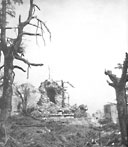
AFTER THE BATTLE. The central square of Cisterna, 26 May 1944
In the early morning hours of 22 January 1944, VI Corps of Lt. Gen.
Mark W. Clark's Fifth Army landed on the Italian coast below Rome and
established a beachhead far behind the enemy lines. In the four months
between this landing and Fifth Army's May offensive, the short stretch
of coast known as the Anzio beachhead was the scene of one of the most
courageous and bloody dramas of the war. The Germans threw attack after
attack against the beachhead in an effort to drive the landing force
into the sea. Fifth Army troops, put fully on the defensive for the
first time, rose to the test. Hemmed in by numerically superior enemy
forces, they held their beachhead, fought off every enemy attack, and
then built up a powerful striking force which spearheaded Fifth Army's
triumphant entry into Rome in June.
The story of Anzio must be read against the background of the
preceding phase of the Italian campaign. The winter months of 1943-44
found the Allied forces in Italy slowly battering their way through the
rugged mountain barriers blocking the roads to Rome. After the Allied
landings in southern Italy, German forces had fought a delaying action
while preparing defensive lines to their rear. The main defensive
barrier guarding the approaches to Rome was the Gustav Line, extending
across the Italian peninsula from Minturno to Ortona. Enemy engineers
had reinforced the natural mountain defenses with an elaborate network
of pillboxes, bunkers, and mine fields. The Germans had also
reorganized
their forces to resist the Allied advance. On 21 November 1943, Field
Marshal Albert Kesselring took over the command of the entire Italian
theater; Army Group C, under his command, was divided into two
armies, the Tenth facing the southern front and also holding
the
Rome area, and the Fourteenth guarding central and northern
Italy. In a year otherwise filled with defeat, Hitler was determined to
gain the prestige of holding the Allies south of Rome.
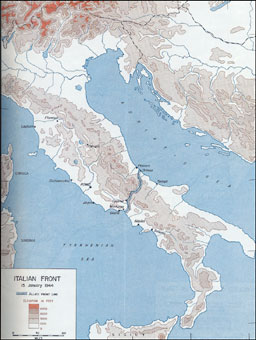
Map No. 1
Italian Front, 15 January 1944
Opposing the German forces was the Allied 15th Army Group, commanded
by Gen. Sir Harold R. L. G. Alexander, with the U.S. Fifth Army
attacking on the western and the British Eighth Army on the eastern
sectors of the front. In mid-December, men of the Fifth Army were
fighting their way through the forward enemy defensive positions, which
became known as the Winter Line.1
--1--
THE ANZIO BEACHHEAD TERRAIN, looking northeast over the flat
plain toward Velletri Gap. In the foreground is the town of Anzio.
Nettuno is on the right. (Photo taken in September 1944.)
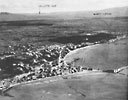
Braving the mud, rain, and cold of an unusually bad Italian winter,
scrambling up precipitous mountain slopes where only mules or human
pack-trains could follow, the Allied forces struggled to penetrate the
German defenses. By early January, Fifth Army troops had broken through
the Winter Line and had occupied the heights above the Garigliano and
Rapido Rivers, from which they could look across to Mount Cassino, with
Highway No. 6 curving around its base into the Liri Valley. Before them
were the main ramparts of the Gustav Line, guarding this natural
corridor to the Italian capital. Buttressed by snow-capped peaks
flanking the Liri Valley, and protected by the rain-swollen Garigliano
and Rapido Rivers, the Gustav Line was an even more formidable barrier
than the Winter Line. Unless some strategy could be devised to turn the
defenses of the Gustav Line, Fifth Army faced another long and arduous
mountain campaign.
--2--
Plan for a New Offensive
The strategy decided upon by the Allied leaders, an amphibious
landing behind the Gustav Line, had been under consideration from the
time when German intentions in Italy became clear. By late October 1943
it was evident that the Germans intended to compel the Allied forces to
fight a slow costly battle up the peninsula. To meet this situation,
Allied staffs began to consider a plan for landing behind the enemy
lines, with the purpose of turning the German flank, gaining a passage
to the routes to Rome, and threatening the enemy lines of communication
and supply. On the Eighth Army front, a small-scale amphibious landing
at Termoli on 2-3 October 1943 furnished a pattern for such an attack.
On 8 November 1943 General Alexander ordered the Fifth Army to plan
an amphibious landing on the west coast. The target date was set at 20
December. The landing, to be made by a single division, was to be the
third phase of an over-all operation in Italy. In the first phase the
Eighth Army was to carry out an offensive which would put it astride
Highway No. 5, running from Pescara on the Adriatic coast through
Popoli
and Collarmele toward Rome. The second phase would be a Fifth Army
drive up the Liri and Sacco Valleys to capture Frosinone. Dependent on
the progress of the first two phases, a landing south of Rome directed
toward Colli Laziali (the Albanese Mountains) would be made, to link up
with the forces from the south. Because of tenacious German opposition
and difficult terrain, the Eighth and Fifth Armies in the Winter Line
campaign could not reach their assigned objectives. This situation,
together with the lack of available landing craft, made the plan for an
immediate amphibious end-run impracticable, and the project was
abandoned on 20 December 1943.
The slow progress of the Allied advance led to the revival of the
plan for an amphibious operation south of Rome along the lines
previously contemplated. At Tunis on Christmas Day the chief Allied
military leaders drafted new plans for an amphibious landing below Rome
with increased forces and the necessary shipping. Two divisions, plus
airborne troops and some armor-over twice the force originally
planned-were to make the initial assault between 20 and 31 January, but
as near 20 January as possible to allow a few days latitude if bad
weather should force postponement. The amphibious operation was again
to
be coordinated with a drive from the south, which would begin earlier.
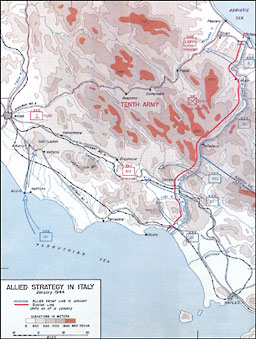
Map No. 2
Allied Strategy in Italy, January 1944
Main Fifth Army, reinforced by two fresh divisions from the
quiescent Eighth Army front, was to strike at the German Tenth Army
across the Garigliano and Rapido Rivers, breach the Gustav Line, and
drive up the Liri Valley. This offensive was planned in sufficient
strength to draw in most of the available German reserves. While the
enemy was fully occupied in defending the Gustav Line, the surprise
landing would be made in his rear at the twin resort towns of Anzio and
Nettuno, about thirty miles south of Rome. Once established, the
assault
force was to thrust inland toward the volcanic heights of Colli
Laziali. The capture of Colli Laziali would block vital enemy supply
routes and threaten to cut off the German troops holding the Gustav
Line. The Allied leaders believed that the Germans lacked sufficient
strength to meet attacks on two fronts and that they would be forced to
rush troops northward to meet the grave threat to their rear. Thus
weakened, the Germans could be forced to withdraw up the Liri Valley
from their Gustav Line positions. Eighth Army, though depleted of two
divisions which were to go to the Fifth Army front, was to make a show
of force along its front in order to contain the maximum number of
enemy
forces. If possible, Eighth Army would reach Highway No. 5 and develop
a
threat toward Rome through Popoli by 20 January. Main Fifth Army was to
follow up the anticipated enemy withdrawal as quickly as possible, link
up with the beachhead force, and drive on Rome.
The area chosen for the amphibious landing was a stretch of the
narrow Roman coastal plain extending north from Terracina across the
Tiber River. (Map
No. 3.)
Southeast of Anzio this plain
--3--
is covered by the famous Pontine Marshes; northwest toward the
Tiber
it is a region of rolling, often wooded, farm country. The 3,100-foot
hill mass of Colli Laziali lies about twenty miles inland from Anzio
and
guards the southern approaches to Rome.
(Map No. 21.)
Highway No. 7 skirts the west side of Colli Laziali; on
the southeast the mountains fall away into the low Velletri Gap leading
inland toward Highway No. 6 at Valmontone. The main west-coast railways
parallel these highways. On the east side of the Velletri Gap rise the
peaks of the Lepini Mountains which stretch along the inner edge of the
Pontine Marshes toward Terracina.
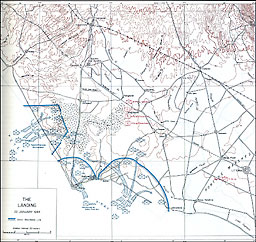
Map No. 3
The Landing, 22 January 1944
An area roughly seven miles deep by fifteen miles wide around Anzio
was to form the initial Allied beachhead.Its 26-mile perimeter was
considered the maximum which
could be held by the initial assault force and yet include the best
natural features for defense, In the sector northwest of Anzio the
beachhead was bounded by the Moletta River, Here the low coastal plain
was cut up by a series of rough-hewn stream gullies, the largest of
them
formed by the Moletta and the Incastro Rivers running southwest from
the higher ground inland toward the sea. These gullies, though their
small streams were easily fordable, were often fifty feet deep and
offered difficult obstacles to armor. In the central beachhead sector,
east of the first overpass on the Anzio-Albano road, the line ran 6,000
yards across a broad stretch of almost level open fields to meet the
west branch
LITTORIA AND THE RIGHT FLANK of the beachhead, viewed from
the
air. The Mussolini Canal flows from right to left across the terrain
shown in this photo, about one-third of the distance between Littoria
and Anzio. The Factory (Aprilia) was very similar in structure, and
built about the same time as Littoria.

--4--
of the Mussolini Canal below the village of Padiglione. This
stretch
of open country leading inland along the Albano road formed the best
avenue of approach into or out of the beachhead and was to be the scene
of major Allied and German attacks.
Between Cisterna and Littoria the plain merged with the northern
edge of the Pontine Marshes, a low, flat region of irrigated fields
interlaced with an intricate network of drainage ditches. The treeless,
level expanse offered scant cover for troops, and during the rainy
season the fields were impassable to most heavy equipment. From
Padiglione east the entire right flank of the initial beachhead line
was
protected by the Mussolini Canal, which drains the northern edge of the
Pontine Marshes, The line ran east along the west branch of the canal
to its intersection with the main branch and from there down the main
branch to the sea. The canal and the Pontine Marshes made the beachhead
right flank facing Littoria a poor avenue of attack; this flank could
be held with a minimum of forces.
Most of the beachhead area was within an elaborate reclamation and
resettlement project. The low, swampy, malarial bogland of the Pontine
Marshes had been converted into an area of cultivated fields, carefully
drained and irrigated by an extensive series of canals and pumping
stations. Only in the area immediately north of Anzio and Nettuno had
the scrub timber, bog, and rotting grazing land been left untouched. At
regular intervals along the network of paved and gravel roads
crisscrossing the farmlands were the standardized 2-story podere,
or farmhouses, built for the new settlers. Such places as the new
community center of Aprilia, called the "Factory" by Allied troops, and
the provincial capital of Littoria, were modernistic model towns. The
twin towns of Anzio (ancient Antium) and Nettuno in the center of the
beachhead were popular seaside resorts before the war.
The plan for the landing was called SHINGLE.
Originally conceived as
a subsidiary operation on the left flank of an advancing Fifth Army, it
developed, when main Fifth Army failed to break the
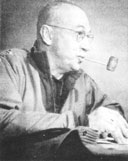
MAJ. GEN. JOHN P. LUCAS
Commanding General, VI Corps
mountain defenses in the south, into a major operation far in the
enemy rear. U.S. VI Corps, selected by General Clark to make the
amphibious landing, employed British as well as American forces under
the command of Maj. Gen. John P. Lucas. The assault force was to be
dispatched from Naples, and was to consist of the U.S. 3d Division,
veteran of landings in Sicily and North Africa, the British 1 Division
from the Eighth Army front, the 46 Royal Tank Regiment, the 751st Tank
Battalion, the 509th Parachute Infantry Battalion, the 504th Parachute
Infantry Regiment, Commandos, Rangers, and other supporting troops.
This
force was the largest that could be lifted by the limited Dumber of
landing craft available. It was estimated that the turnaround would
require three days. As soon as the convoy returned to Naples, the U.S.
45th Division and the U. S. 1st Armored Division (less Combat Command
B), were sent as reinforcements.
The final plans for SHINGLE were completed and
approved on 12
January. D Day was set for
--5--
22 January; at H Hour (0200), VI Corps was to land over the
beaches
near Anzio and Nettuno in three simultaneous assaults. On the right,
the
3d Division, under Maj. Gen. Lucian K. Truscott, Jr., would land three
regiments in assault over X-Ray Red and Green Beaches, two miles below
Nettuno.2
In the center, the
6615th Ranger Force (Provisional) of three battalions, the 83d Chemical
Battalion, and the 509th Parachute Infantry Battalion would come in
over
Yellow Beach, a small beach adjacent to Anzio harbor, with the mission
of
seizing the port and clearing out any coastal defense batteries there.
On
Peter Beach, six miles northwest of Anzio, the 2 Brigade Group of the
British
1 Division, commanded by Maj. Gen. W. R. C. Penney, would make the
assault; the 2 Special Service Brigade of 9 and 43 Commandos would land
with it and strike east to establish a road block on the main road
leading from Anzio to Campoleone and Albano. All these forces would
link
up to seize and consolidate a beachhead centering on the port of Anzio.
(Map No. 3.)
The assault plan assumed the possibility of initial heavy resistance
on the beaches, and the certainty of heavy counterattacks once the
enemy
was fully aware of the extent of the landing. Consequently, VI Corps
held out a strong reserve and placed great emphasis on digging in early
at initial objectives to repel armored counterattacks. The bulk of the
1
Division, with the 46 Royal Tank Regiment, the 24 Field Regiment, and
the So Medium Regiment attached, was to remain on shipboard as a
floating reserve. The 504th Parachute Infantry would land behind the 3d
Division and also assemble in Corps reserve. Up to a few days before
the
landing, it had been intended to drop the paratroopers behind the
beaches. This drop was called off because its objective was about the
same as that of the 1 Division, and because dropping before H Hour
might
prematurely reveal the main assault. A drop at H Hour itself might
incur the danger of being fired on by Allied artillery if enemy planes
should attack at the same time.
The Allied High Command expected that a landing in strength to the
rear of XIV Panzer Corps, opposing main Fifth Army on the
Cassino front, would be considered an emergency to be met by all the
resources of the German High Command in Italy. From the latest
intelligence available on enemy troops in the Rome area, Army G-2
estimated that VI Corps could expect an initial D Day resistance from
one division assigned to coast watching' four parachute battalions from
Rome, a tank and an antitank battalion, and miscellaneous coast defense
personnel, totaling 14,300 men. By D plus 1, another division, an SS
infantry regiment from north of Rome, a regimental combat team from XIV
Panzer Corps reserve, and perhaps elements of the Hermann
Goering Panzer Division could arrive. By D plus 2 or 3 the enemy
might have appreciated that the Allies had weakened the Eighth Army
front; if so, he could bring the 26th Panzer Division from that
sector to produce a total build-up of 31,000 men. If the Fifth Army
attack in the south were sufficiently powerful and sustained, it should
pin down all enemy reserves in that area. G-2 did not believe that the
Germans could bring down reinforcements quickly from northern Italy,
especially in the face of overwhelming Allied air superiority. Probable
build-up from north of Florence was estimated to be not more than two
divisions by D plus 16. The final summary by G-2, Fifth Army, on 16
January pointed out the increasing attrition of enemy troops:
Within the last few days there have been increasing
indications that enemy strength on the Fifth Army front is ebbing, due
to casualties, exhaustion, and possibly lowering of morale. One of the
causes of this condition, no doubt, has been the recent, continuous
Allied attacks. From this it can be deduced that he has no fresh
reserves and very few tired ones. His entire strength will probably be
needed to defend his organized defensive positions.
In view of the weakening of enemy strength on the front as
indicated above, it would appear doubtful if the enemy can hold the
organized defensive line through
--6--
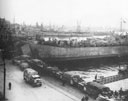
PRELOADED SUPPLY TRUCKS AND DUKW's at Naples on 18 January
are loaded aboard LST's. This novel supply method was getting its first
Mediterranean battle test in the Anzio beachhead operation.
Cassino against a coordinated army attack. Since this
attack is to be launched before Shingle, it is considered likely that
this additional threat w ill cause him to withdraw from his defensive
position once he has appreciated the magnitude of that operation.
Whatever the enemy resistance and coast defenses might be, two natural
obstacles, bad weather and poor beaches, made a landing at Anzio in
January extremely hazardous. The winter rainy season was the worst time
of year to launch an amphibious assault. Rain, low clouds, and high
seas
promised to complicate the problem of supply over the beaches and to
hamper air support. The beaches themselves, much shallower than those
at Salerno, had the added disadvantage of two offshore sandbars. The
Navy estimated that only smaller craft such as LCVP's, LCA's, and
DUKW's could be landed with any reasonable
--7--

TROOPS FILING ABOARD AT NAPLES for the invasion were in a
happy
frame of mind when this picture was taken. A part of the 6615th Ranger
Force (Provisional), they were transported to Anzio aboard the stubby
LCI's shown in the background.
hope of success.3
These risks had to be accepted, although
special precautions could be taken to minimize their effect. Since the
weather promised only two good days out of seven, the assault convoy
was
to be combat-loaded for complete discharge within two days; to permit
larger craft to unload over the shallow beaches, pontons were to be
carried to serve as mobile piers; and to decrease the turnaround time
of
craft, the novel method of loading LST's with preloaded supply trucks
was to be used for the first time in the Mediterranean Theater. The
trucks were to load at Naples, drive onto the LST's, and drive off
again at Anzio. It was hoped that the small port of Anzio could be
captured before the enemy had time to demolish it. Its capture intact
would help to ease the grave problem of supply over open and exposed
beaches.
To protect the establishment of the beachhead an elaborate air
program in two phases was projected. Prior to D Day the Tactical Air
Force would bomb enemy airfields to knock out the German Air Force, and
would seek to cut communications between Rome and the north which enemy
reinforcements might use. The Strategic Air Force would assist in these
tasks. Then, from D Day on, every effort would be made to isolate the
beachhead from enemy forces by maintaining air superiority over the
beachhead, bombing bridges and road transport, and attacking enemy
columns or troop concentrations within striking distance.
--8--
For this program much of the strength of the Tactical Air Force
would be available, and assistance from other Allied air power in the
Mediterranean Theater would be on call. Support would be drawn from
some
2,600 Allied aircraft in Italy, Corsica, and Sardinia, representing an
overwhelming superiority over available German air power. XII Air
Support Command, under Maj. Gen. E. J. House, reinforced by two groups
from the Desert Air Force, would provide direct air support, while the
Tactical Bomber Force flew heavier missions. The Coastal Air Force
would give day and night fighter cover to the mounting area at Naples
and halfway up the convoy route. From here on the 64th Fighter Wing
would cover the battle area. A total of 60 squadrons (23½
fighter, 6 fighter-bomber, 4 light bomber, 24 medium bomber, and
2½ reconnaissance) would directly support the ground effort.
Enemy air power was not considered a major threat. By early January
almost the entire long-range bomber force of the Second German Air
Force, under General Baron von Richthofen, had disappeared from
Italian fields. it was believed that Allied attacks on enemy bases
would reduce the remaining German air strength by 60 percent, It was
not considered likely that the German Air Force would reinforce its
units in Italy to meet SHINGLE, so the enemy air
effort, never strong,
should gradually diminish.
Rear Admiral F. J. Lowry, USN, commander of Task Force 81, was
charged with the responsibility of mounting, embarking, and landing the
ground forces and with the subsequent support of this force until it
was
firmly established ashore. His assault convoy numbered 2 command ships,
4 Liberties, 8 LSI's, 84 LST's, 96 LCI's, and 50 LCT's, escorted by
cruisers, destroyers, and a host of lesser craft. It was divided into
two groups, Task Force X-Ray under Admiral Lowry to lift the American
troops, and Task Force Peter under Adm. T. H. Troubridge, RN, for
British troops.4
Since only sixteen 6-davit LST's were available, the eight LSI's had
been assigned to provide additional assault craft. Even with this
addition, LCI's would have to be used for follow-up waves over X-Ray
Beach. Peter Beach was so shallow that only light assault craft could
be
used.
Task Force X-Ray was further divided into several functional groups:
a control group of two flagships; a sweeper group to clear a mine-free
channel; and an escort group for antiaircraft and submarine protection.
A beach identification group was designated to precede the assault
craft, to locate the beaches accurately, and mark them with colored
lights. Then three craft groups would land the assault waves. Following
the first wave, the 1st Naval Beach Battalion would improve the marking
of beach approaches and control boat traffic. A salvage group was
assigned to lay ponton causeways after daylight for unloading heavier
craft. Back at Naples a loading control group would handle berthing and
loading of craft.
To gain surprise no preliminary naval bombardment of the beaches was
ordered, except a short intense rocket barrage at H minus 10 to H minus
5 minutes by three LCT(R)'s. An important assignment, however, was
given
to a naval task force which was to deliver a feint at H Hour of D Day
by
bombarding Civitavecchia, north of Rome, and by carrying out dummy
landings.
--9--
The Germans foresaw the possibility of an Allied landing behind
the
Gustav Line, and strengthened the coastal positions that were in the
most likely invasion areas as best they could with the limited number
of
troops at their disposal. Since it considered the number of German
troops in Italy barely sufficient to hold the southern front and
strengthen the rear areas, the German High Command in December 1943
worked out an elaborate plan to reinforce German troops in Italy with
units from France, Germany, and Yugoslavia in the event of an Allied
landing. Thus it was that while the Germans realized that they did not
have available sufficient forces to prevent an Allied landing behind
the
Gustav Line, they believed that they could contain and then destroy it
by hurrying reinforcements into Italy to meet the emergency. Their
plans did not contemplate the withdrawal of any substantial number of
troops from the southern front to meet such a threat to their rear.
The bitter and continuous struggle along the southern front from
November 1943 into January 1944 forced the enemy to commit all of his
divisions that were fit for combat to stop the Allied offensive at the
Gustav Line. A lull in the fighting in early January permitted the
strengthening of forces in the Rome area to resist an invasion. Under
the command of I Parachute Corps, the 29th and
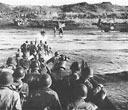
--10--
THE ANZIO LANDING was virtually unopposed. These
scenes,
photographed at Yellow Beach soon after down on 22 January, show troops
of the 3d Division (above) as they waded the last few yards to shore
and
(below) a line of vehicles moving inland. White tape indicates boundary
of the path to which vehicles were confined by soft ground in the area.

90th Panzer Grenadier Divisions were assigned to the Rome
coastal sector; the Herman Goering Panzer Division was held as
a
mobile reserve between Rome and the southern front. But when the
American Fifth Army attacked across the Garigliano on 18 January, the
Germans rushed the 29th and 90th Panzer Grenadier Divisions
southward. On the eve of the Anzio landing, the Germans had almost
denuded the Rome area of combat troops in order to stem the Allied
drive
in the south. They had observed the regrouping of Allied troops and
Allied naval preparations in the Naples area; and they believed that
the Allies had sufficient strength both to maintain the offensive along
the main fighting front and to attempt a landing in the Rome area. But
they hoped to delay such an invasion by counterattacking in the south;
then, after stopping the Allies on the Garigliano, they would draw back
enough troops to check a landing.
The Assault
In early January, VI Corps troops assembled in the Naples area to
embark on a short but strenuous amphibious training program. Night
operations and physical conditioning through speed marches were
stressed. Infantry battalions practiced special beach assault tactics,
landings under simulated
--11
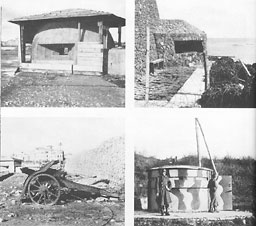
ENEMY COASTAL DEFENSES were sparse and mostly unmanned.
These
four photos, all taken in the Nettuno area, show the type of defenses
the Germans had set up. The cannon is an obsolete model.
fire, removing mine fields and barbed wire, and knocking out
pillboxes on the beach. Artillerymen learned the knack of loading and
unloading DUKW-borne 105-mm. howitzers. Assault landings were practiced
and repracticed, first from mock-ups on dry land and then in battalion
and regimental landing exercises with craft provided by the Navy. The
program culminated in WEBFOOT, a Corps landing
exercise lasting from 17
to 19 January on the beaches south of Salerno.5
As D Day approached, massed squadrons of medium and heavy bombers
roared out toward
--12--
northern Italy to strike the first blow in the new offensive.
Their
role was to choke off the vulnerable Italian rail and highway routes
down which enemy supplies and reinforcements could flow toward the
beachhead and the southern front. Shifting their weight from one main
line to another, Fortresses, Liberators, Mitchells, Marauders, and
Wellingtons hammered at key bridges and railroad yards from Rome north
to the Brenner Pass. Closer to the front, fighters and light bombers
strafed and bombed transport on the rail and highway nets. Finally, a
few days before the landing, heavy bombers flew missions against key
airfields in Italy and southern France to forestall any interference
from the Luftwaffe with the Anzio assault.
While the Anzio landing was stilt in preparation, main Fifth Army
began its southern drive. At dawn on 12 January, troops of the French
Expeditionary Corps surged forward in the mountains above Cassino.
While
the French sought to turn the German left flank above Cassino, the
British 10 Corps struck across the lower Garigliano to pierce the other
flank of the Gustav Line. In spite of successive assaults neither the
British nor the French were able to break through the rock-ribbed wall
of German mountain defenses. In the center, on 20 January, the U.S. II
Corps attacked in an effort to cross the Rapido and secure a
bridgehead. After gaining a precarious foothold in two days of bitter
fighting, heavy losses forced it to withdraw. By 22 January, D Day for
the Anzio landing, the attack on the Gustav Line had bogged down in the
midst of savage German counterattacks. Although Fifth Army had not
succeeded in driving up the Liri Valley, the battle for Cassino
continued
and the Germans had been forced to commit most of Tenth Army's
reserves. High hopes were still held that the Anzio landing would break
the stalemate in the Liri Valley.
During the third week in January, Naples and its satellite ports
were the scene of feverish activity as troops and supplies were loaded
on a convoy of more than 250 ships and craft. Long lines of
waterproofed
vehicles rolled down to the docks and troops filed aboard the waiting
ships. As dawn colored the hills above the Bay of Naples on 21 January,
the first ships slipped their hawsers and the convoy sailed.
It had been impossible to conceal craft concentrations in the Naples
area, but elaborate efforts were made to deceive the enemy as to the
time and place of the assault, which might fall anywhere from Gaeta to
Leghorn. The convoy plowed north from Naples at a steady 5-knot pace,
swinging wide on a roundabout course to deceive the enemy as to its
destination and to avoid mine fields. Allied air raids, however, had
temporarily knocked out the German reconnaissance base at Perugia, and
not an enemy plane was sighted in the sunlit sky. Mine sweepers cleared
a channel ahead, destroyers and cruisers clung to the flanks to ward
LT. GEN. MARK W. CLARK, Commanding General of the Fifth
Army,
arriving at the beachhead on D Day morning in a Navy PT boat. He is
shown reading radio dispatches on the battle's progress with a Fifth
Army Staff officer.
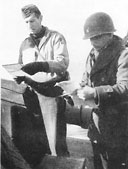
--13--

A DESTROYED MUSSOLINI CANAL BRIDGE near Borgo Sabotino, part
of
the reconnaissance effort on the right flank on D Day. Photo, taken
later, shows a treadway bridge over the canal, concrete road blocks
(German) on the far side, and a trench system dug by American forces.
off U-boats, and an air umbrella of fighters crisscrossed
constantly. Actually, these elaborate precautions were hardly
necessary,
for the enemy air reconnaissance failed to observe either the
embarkation at Naples or the approach of VI Corps to Anzio, Aboard the
convoy men tolled about the decks, sleeping or sunbathing, checking
equipment, or excitedly discussing what they would find. As night felt
and darkness cloaked the convoy's movements, it swung sharply in toward
Anzio.
At five minutes past midnight on 22 January, in the murky blackness
off Cape Anzio, the assault convoy dropped anchor and rode easily on a
calm Mediterranean Sea. There was a murmur of subdued activity as
officers gave last-minute instructions, men clambered into stubby
assault craft, and davits swung out and lowered them to the sea. Patrol
boats wove in and out of the milling craft herding them into formation,
and then led the first waves away into the moonless night.
To gain surprise the guns of the escorting warships kept silent.
Then, just ten minutes before H Hour (0200), a short, terrific rocket
bombardment from two British LCT(R)'s burst with a deafening roar along
the beach. These newly developed rocket craft, each carrying 798 5-inch
rockets, were employed to disorganize any possible enemy ambush,
explode
mine fields along the beach, and destroy enemy beach defenses. But the
attackers saw no burst of answering fire; when the rocket ships ceased
firing, the shore again loomed dark and silent ahead.
As the first wave of craft hit the beach and men rushed for the
cover of the dunes behind, there was no enemy to greet them. Pushing
rapidly inland the astonished troops soon realized that the highly
unexpected had happened. They had caught the enemy completely off
guard.
Although the Germans knew an amphibious landing was impending, they
believed that it would not occur until somewhat later. The two
divisions that had been assigned to guard this coast had been sent to
the southern front only three days before, and the coastal sector and
area south of Rome were held by only skeleton forces. Consequently,
except for a few small coast artillery and antiaircraft detachments,
the
only immediate resistance to the Anzio landing came from scattered
elements of the 29th Panzer Grenadier Division. Only three
engineer companies and the 2d Battalion, 71st Panzer Grenadier
Regiment, had been left to guard the coast from the mouth of the
Tiber River through Anzio to the Mussolini Canal; one 9-mile stretch of
the coast was occupied by a single company. Furthermore, the troops in
the Anzio area had not been warned that an Allied landing was imminent.
The coastal defenses were limited to scattered mine fields along Peter
Beach used by the British 1 Division; some pillboxes, most of which
were
not even manned; and scattered artillery pieces-a few 88's and several
old Italian,
--14--
French, and Yugoslav pieces-most of which were not even fired
against the attackers.
Aided by a calm sea and the virtual absence of opposition, the
invaders quickly established themselves on shore.
(Map No. 3.)
On the right, the 3d Division swept in over the beaches
east of Nettuno. Brushing aside a few dazed enemy patrols, they pushed
rapidly inland, established themselves on the initial phase line, and
dug in to repel any counterattack. General Clark, accompanied by Brig.
Gen. Donald W. Brann and other members of the Fifth Army Staff, arrived
at the beachhead in a Navy PT boat, transferred to a DUKW, and landed
at 1000. Motorized patrols of the 3d Reconnaissance and Provisional
Reconnaissance Troops forged ahead to seize and blow the bridges over
the Mussolini Canal which ran along the right flank. Only at the
southernmost bridge did they meet any Germans. Here they knocked out
three armored cars with bazookas,
ENGINEERS CLEARING DEMOLITION CHARGES IN ANZIO on
D Day. The Germans failed to carry out their plans to destroy the port.
Explosives, such as these men of the 36th Engineers are seen removing
had been set so that buildings would topple into the streets, and thus
hinder use of port facilities.

--15--
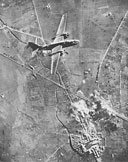
AN AIR ATTACK ON CISTERNA by medium bombers shows smoke and
dust
rising from bomb hits on enemy installations and the railroad just
south
of the town. Note the narrow, winding Cisterna Creek directly below
plane.
--16--
killing or capturing eleven of the enemy patrol.
The Ranger Force landed over the small beach just to the right of
Anzio harbor and swiftly seized the port. The Rangers scrambled up the
steep bluff, topped with pink and white villas overlooking the beach,
and spread through the streets of the town, rounding up a few
bewildered
defenders. The Germans had had no time to demolish the port facilities.
Except for a gap in the mole and some battered buildings along the
waterfront (damage caused by Allied bombers), the only obstacles were a
few small vessels sunk in the harbor. Later in the morning the 509th
Parachute Infantry Battalion advanced east along the shore road and by
1015 occupied Nettuno. Northwest of Anzio the landing of the British 1
Division was equally unopposed, although delayed by poor beach
conditions. By noon of D Day VI Corps had reached all its preliminary
objectives ashore.
In support of the landing, Allied fighter and bomber squadrons flew
more than 1,200 sorties on D Day. Medium and heavy bombers blasted key
bridges and such road junctions as Cisterna and Velletri in an attempt
to block the main roads leading toward the Anzio area. Fighter-bombers,
fighters, and night intruders ranged these highways, bombing and
strafing the enemy traffic beginning to surge toward the beachhead.
Other fighters gave continuous air cover to the landing force. Enemy
air
attacks were comparatively slight on D Day, totaling 140 sorties, but
increased in intensity on 23 January.

PUTTING DOWN ROAD MATTING at the beach exits was one of the
problems confronting the engineers after the landings. Many heavy
vehicles and the rapid supply build-up made the construction of a
number
of such roadways necessary.
--17--
Behind the assault troops pushing inland, unloading of the initial
convoy proceeded at a rapid pace. Engineers swiftly cleared the
scattered mine fields and bulldozed exit roads across the dunes; but
the
clay soil between the beaches and the main road soon became so badly
rutted that matting, corduroy, and rock had to be laid down to make the
area passable. DUKW's and small craft scurried back and forth across
the calm waters of Nettuno Bay, busily unloading the larger craft which
were unable to approach the shallow beach. In spite of sporadic
shelling after daylight from a few long-range German batteries inland
and three small hit-and-run raids by Luftwaffe fighter-bombers, the
540th Engineers quickly moved streams of men and supplies across the
beach. A mine sweeper hit a mine and one LCI was sunk by the bombs, but
this was the only major damage. The 36th Engineers began clearing the
debris from the port of Anzio; the Navy hauled away the sunken vessels.
By early afternoon the port was ready to handle LST's and other craft.
When the British beach northwest of Anzio proved to be too shallow for
effective use, it was closed and British unloading switched to the
newly opened port. By midnight of D Day some 36,000 men, 3,200
vehicles, and large quantities of supplies were ashore, roughly 90
percent of the equipment and personnel of the assault convoy.
Casualties for D Day were light. Thirteen killed, ninety-seven
wounded, and forty-four captured or missing were reported to VI Corps,
Two hundred and twenty-seven prisoners were taken. Against negligible
opposition VI Corps had reached its preliminary objectives and captured
almost intact the port of Anzio, which was to be the key channel for
supplies.
Expanding the Beachhead
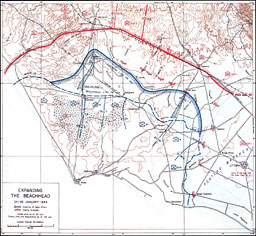
Map No. 4
Expanding the Beachhead, 24-28 January 1944
Having reached its preliminary objectives by noon of D Day, VI Corps
moved forward to occupy the ground within the planned initial beachhead
line. The British 1 Division advanced from its beaches on the left
toward the Moletta River and gained control of seven miles of the
Albano
road. In the 3d Division sector the advance resolved itself into a
series of actions to gain the bridges over the Mussolini Canal, vital
to the defense of the right side of the beachhead.
By the evening of D Day, advance guards of the 30th Infantry and the
3d Reconnaissance Troop

--18--
UNLOADING AT ANZIO'S DOCKS began D Day afternoon when
the engineers
cleared the harbor. LST's (above) were able to nose directly into the
docks and soon afterward British troops (below) were moving through the
battered port instead of over the shallow northern beaches.
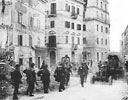
had seized all of the bridges across the canal. The enemy regained
most of the bridges that night in attacks by aggressive, tank-supported
attacks launched by elements of the Hermann Goering Panzer Division.
The next morning Lt. Col. Lionel C. McGarr, commander of the 30th
Infantry, brought up the remainder of his regiment, supported by tanks
and tank destroyers; in sharp fighting it drove the enemy back across
the bridges along the west branch. The Germans counterattacked with
three tanks and a half-track to regain the bridge on the Cisterna road
north of Conca, but the 30th Infantry's supporting armor drove them
off.
On the right of the 30th Infantry, the 504th Parachute Infantry, which
had come ashore in Corps reserve, on 24 January relieved the 3d
Reconnaissance Troop along the main canal and retook the other lost
bridges.
--19--
By 24 January the 3d Division had occupied the right sector of the
initial beachhead along the Mussolini Canal. The 504th Parachute
Infantry held the right flank along the main canal; in the center the
15th Infantry, and on its left the 30th Infantry, faced Cisterna along
the west branch. Ranger Force relieved all but the 3d Battalion, 7th
Infantry, on the division left in the quiet central beachhead sector.
Meanwhile the 2 Brigade of the 1 Division, under the command of Brig.
E.
E. J. Moore, rounded out its sector of the beachhead by advancing to
the Moletta River line. The remainder of the division was held in Corps
reserve in anticipation of an enemy counterattack. In two days VI Corps
had secured a beachhead seven miles deep against only scattered
opposition.
Although the Anzio landing and initial Allied build-up were
virtually unopposed by German land forces, the enemy reacted swiftly to
meet the emergency. Headquarters of Army Group C immediately
alerted elements of the 4th Parachute and Hermann Goering
Panzer Divisions south of Rome and ordered them to defend the roads
leading from Anzio toward Colli Laziali. At 0600 on 22 January it set
in
motion the prearranged plan to rush troops from outside of Italy to
stem the Allied invasion. Two divisions and many lesser units started
at
once from France, Yugoslavia, and Germany itself. Three divisions of
the Fourteenth Army in northern Italy were alerted and left for
the Rome area on 22-23 January. To command the defense, I Parachute
Corps reestablished its headquarters in the area below Rome at 1700
on 22 January. All available reserves from the southern front or on
their way to it were rushed toward Anzio; these included the 3d
Panzer Grenadier and 71st Infantry Divisions, and the bulk
of
the Hermann Goering Panzer Division. While these forces were
assembling, the German Air Force bombed the beachhead area and its
supporting naval craft in order to delay an Allied advance inland. For
the first two days, the German defenders believed that
ADVANCING TOWARD THE MUSSOLINI CANAL, elements
Of the 504th Parachute Infantry on D Plus 2 moved in small groups and
then only when protected by smoke screens. The canal is just beyond the
smoke on the horizon, about 1,000 yards from the building in the
foreground.

--20--
they were too weak to stop an Allied advance against Colli
Laziali;
but from the evening of 24 January they were confident that they could
contain the beachhead forces and, as soon as they had substantially
completed their concentration, launch a counterattack that would wipe
out the Allied beachhead.
Army Group C on 24 January ordered the Fourteenth Army
to take over the command of the German operations before Anzio. When
the Fourteenth
Army, commanded by Gen. Eberhard von Mackensen, assumed control on
25 January, elements of eight German divisions were employed in the
defense line around the beachhead, and five more divisions with many
supporting units were on their way to the Anzio area. By 28 January, Fourteenth
Army had assigned command of the forces defending the eastern
sector
of the beachhead perimeter (before Cisterna) to the Hermann Goering
Panzer Division; of the central sector (before Campoleone) to the 3d
Panzer Grenadier Division; and of the western sector (behind the
Moletta River) to the 65th Infantry Division. Behind this
perimeter other units were grouped for counterattack. A gap of four or
five miles separated the German main line of resistance from the main
beachhead line occupied by the Allied VI Corps by 24 January.
The reaction of enemy forces gave no impetus to main Fifth Army's
drive and made the prospect of linking the southern force with the
beachhead remote. Also, if VI Corps extended itself too far inland
toward Colli Laziali, its main objective, it would risk being cut off
by
a sudden German counterthrust. Before the end of D Day the Germans were
estimated to have 20,000 troops in areas from which they could drive
rapidly toward the beachhead. With the advantage of good
communications, roads, and railroads, and in spite of Allied air
interdiction, they had doubled that figure by D plus 2, and continued
to
increase it to more than 70,000 by D plus 7. This growing strength
indicated that VI Corps would have to prepare to meet an enemy thrust
calculated to drive the Allied forces back into the sea.
VI Corps consequently consolidated its positions during the period
24-29 January. White awaiting reinforcements, Allied troops probed
along
the two main axes of advance toward the intermediate objectives of
Cisterna and Campoleone, which would serve as strategic jump-off points
for the advance an Colli Laziali. On the right the 3d Division moved up
the roads leading across the Mussolini Canal toward Cisterna; on the
left the British pushed up the Albano road toward
Campoleone.6
(Map No. 4.)
On the afternoon of 24 January, four companies of the 15th and 30th
Infantry made a preliminary reconnaissance in force toward Cisterna,
but
they were unable to make much headway against strong enemy mobile
elements, General Truscott then ordered an advance in greater force at
dawn on 25 January up the two main roads leading across the muddy
fields
toward the town. The 1st Battalion, 30th Infantry, advanced up the
left-hand or Campomorto-Cisterna road, while the 2d Battalion, 15th
Infantry, took the right up the Conca-Cisterna road.
About two miles beyond the canal the 30th Infantry was halted by a
company of the Hermann Goering Panzer Division, intrenched
around the road junction halfway to Ponte Rotto. On the right of the
30th Infantry, the 2d Battalion, 15th Infantry, gained one and one-half
miles up the Conca-Cisterna road before it was stopped by German
machine
gunners concealed within the farmhouses along the route. Tanks and tank
destroyers of the 751st Tank Battalion and the 601st Tank Destroyer
Battalion were brought up to reduce these strong points. Before the
armor could go into action German units infiltrated down a stream bed
forcing the outposts along the 2d Battalion's right flank to withdraw.
Company C, which was making a diversionary attack up a parallel road to
the right of the Conca-Cisterna road, bogged down before similar
resistance and four of its accompanying tanks were lost to an enemy
self-
--21--
propelled gun. With unexpected strength the veteran Hermann
Goering Panzer Division had blunted the spearheads of the 3d
Division
attack. Not having time to prepare fixed defenses, the Germans had
emplaced machine guns and antitank guns in every farmhouse along the
roads. These strong points had excellent interlocking fields of fire
across the gently rolling fields and were supported by roving tanks and
self-propelled guns. They had to be knocked out one by one by American
tanks and tank destroyers before the infantry could advance.
To assist the main effort, paratroopers of the 504th Parachute
Infantry made a diversionary attack across the main canal toward
Littoria. Advancing behind a heavy curtain of supporting fires,
augmented by the guns of the cruiser Brooklyn and two
destroyers,
they captured the villages of Borgo Sabotino, Borgo Piave, and Sessano
on the east side of the canal. Company D, however; was cut off beyond
Borgo Piave by a surprise counterthrust of five tanks and eight flakwagons
(self-propelled antiaircraft guns) of the Hermann Goering Panzer
Division. Company D lost heavily, though many of the men managed to
infiltrate back. That night the 504th Parachute Infantry, leaving
behind strong combat patrols, withdrew from its exposed positions.
The 3d Division resumed its push toward Cisterna the next morning,
26 January. In the 30th Infantry zone the 1st Battalion infiltrated
around the road junction below Ponto Rotto where it had been held up,
and forced the enemy to withdraw. That afternoon the 1st Battalion,
15th
Infantry thrust northeast up the right-hand road across the west branch
of the canal to establish a road block on the Cisterna-Littoria road.
In spite of seventy minutes of massed supporting fire from the 9th,
10th, and 39th Field Artillery Battalions, and neutralizing fire by
heavier guns, the Germans clung tenaciously to their positions. Behind
a similar elaborate artillery preparation, the 2d Battalion, 15th
Infantry, on 27 January pushed up the Conca-Cisterna road. At the same
time the 1st Battalion, 15th Infantry, continued its attack on the
right. It gained some ground but was unable to break
THE RIGHT FLANK AT THE MUSSOLINI CANAL was
covered by the 504th Parachute Infantry, dug in on the east bank. This
position was west of Littoria, toward which a diversionary attack was
launched in support of the 3d Division on 25 January.

--22--

ENEMY SHELLFIRE HITTING THE BEACHES did not halt the work of
DUKW's which carried supplies from Liberty ships offshore. This
sporadic
shelling was considered a nuisance, but caused only limited damage.
through to its objective. Rushing new units into the line piecemeal
as fast as they arrived, the Germans were making every effort to keep
the Americans from reaching Highway No. 7. In the attacks of 25-27
January the 3d Division reached positions one to two miles beyond the
west branch of the Mussolini Canal; it was still three miles from
Cisterna. It became evident that an effort greater than was immediately
possible would be necessary to reach the division's objective. General
Truscott therefore called a halt in the advance to regroup for a more
concentrated drive.
To parallel the drive of the 3d Division, the British 1 Division had
been ordered to move up the Albano road to Campoleone, to secure this
important road and railway junction as a jump-off point for a further
advance. With the arrival of the 179th Regimental Combat Team (45th
Division), VI Corps released from Corps reserve the 24 Guards Brigade
for this move. A strong mobile patrol up the road on 24 January
surprised an enemy outpost at Carroceto, and continued four miles
farther inland to a point north of Campoleone. To exploit this apparent
enemy weakness, General Penney on 25 January dispatched the 24 Guards
Brigade, with one squadron of the 46 Royal Tanks and one medium and two
field regiments of artillery in support, to take the Factory (Aprilia)
near Carroceto. The 3d Battalion, 29th Panzer Grenadier Regiment
(3d
Panzer Grenadier Division),
--23--
however, had occupied the Factory the night before. The 1 Scots
Guards and 1 Irish Guards pushed through a hasty mine field across the
road, and the 5 Grenadier Guards then drove the enemy from the Factory,
capturing 111 prisoners. (Map No. 4)
The enemy, sensitive to the loss of this strong point,
counterattacked strongly the next morning. Twenty tanks and a battalion
of the 29th Panzer Grenadier Regiment thrust at the 5 Grenadier
Guards in the Factory. Their main assault was repulsed, but they
continued to feel around the flanks until they were finally driven off
that afternoon. The Germans left behind four burning tanks, one
self-propelled gun, and forty-six more prisoners. By the morning of 28
January the 24 Guards Brigade had advanced one and one-half miles north
of the Factory. The 1 Division then paused to regroup for an attack on
Campoleone.
By 29 January, VI Corps had expanded its beachhead by the advances
of the 1 and 3d Division, but was still from two to four miles short of
its two intermediate objectives. It was clear that an attack in greater
strength would be necessary to continue the drive. The Corps paused to
regroup.
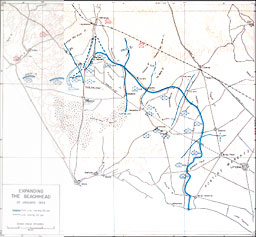
Map No. 5
Expanding the Beachhead, 29 January 1944
Behind the assault troops pushing inland, engineers and service
troops worked day and night to organize the beachhead and prepare a
firm
base for the main attack. Roads were repaired, dumps established, and a
beginning made on defenses to meet any future German counterthrusts.
The port, vital to the supply build-up and troop reinforcement, was
placed in such effective operation that by 1 February it could handle 8
LST's, 8 LCT's, and 5 LCI's simultaneously. Liberty ships, however,
were unable to enter the shallow harbor and continued to be unloaded by
DUKW's and LCT's over X-Ray and Yellow Beaches. The weather during the
first week at Anzio turned out much better than anticipated and greatly
facilitated the stockage of supplies. The port was usable in all but
the worst weather, and only on two days during the first week, 24 and
26 January, was unloading over the beaches halted by high winds and
surf. A gale during the night of 26 January blew ashore all ponton
causeways and beached 12 LCT's, 1 LST, and 1 LCI. In spite of these
interruptions and enemy interference, 201 LST's and 7 Liberty ships had
been completely unloaded by 31 January. On the peak day of 29 January
6,350 tons were unloaded: 3,155 tons through the port, 1,935 over X-Ray
Beach, and 1,260 over Yellow Beach.
The beach and port areas, still within range of German artillery,
were vulnerable targets for increasing shelling. Long-range 88-mm. and
170-mm. batteries dropped their shells sporadically on ships off shore
and among troops working along the beach. Although this fire was a
nuisance to the troops and interfered with work, it caused only limited
damage in the early days. Floating mines continued to be a menace,
damaging a destroyer and a mine sweeper. On 24 January an LST carrying
Companies C and D, 83d Chemical Battalion, struck a mine. Most of the
men were transferred to an LCI alongside, which also hit a mine and
sank. Total casualties were 5 officers and 289 men.
Far more dangerous to beach and shipping were the constant Luftwaffe
raids. The German Air Force put up its biggest air effort since Sicily
in an attempt to cut off Allied supplies. Small flights of
fighter-bombers strafed and bombed the beach and port areas every few
hours. The most serious threat, however, was the raiding by medium
bomber squadrons hastily brought back from Greece and the torpedo and
glider bombers from airfields in southern France. Skimming in low at
dusk from the sea through the smoke and hail of ack-ack fire, they
released bombs, torpedoes, and radio-controlled glider bombs on the
crowded shipping in the harbor. In three major raids, on 23, 24, and 26
January, they sank a British destroyer and a hospital ship, damaged
another hospital ship, and beached a Liberty ship. The two heaviest
raids came at dusk and midnight on 29 January, when 110 Dornier 217's,
Junkers 88's, and Messerschmitt 210's sank a Liberty ship and the
British antiaircraft cruiser Spartan.
Stiffening air defenses took a heavy toll of the Luftwaffe raiders,
downing ninety-seven of them before 1 February. Initially Col. Edgar W.
King
--24--

ANTIAIRCRAFT GUNS AND BARRAGE BALLOONS appeared in
increasing
numbers as the German air raiders stepped up their attacks. The crew
above mans a 40-mm. Bofors gun. Shown below is one of the low-level
type
balloons designed to counter strafing attacks.

--25--
of the 68th Coast Artillery Regiment (Antiaircraft) and later
Brig.
Gen. Aaron A. Bradshaw, Jr., supervised the installation of increasing
numbers of 40-mm. and 90-mm. antiaircraft guns and established a
12,000-yard inner artillery zone around the vital beach and port areas.
Barrage balloons were raised to halt low-level bombing and smoke
screens
blanketed the port at dusk and on every red alert. The enemy's favorite
tactic was to sneak over at dusk, when Allied planes, which needed
daylight to take off, were returning to their 100-mile distant bases.
To combat these sneak raids the engineers renovated the old Italian
artillery school air strip at Nettuno. P-40's of the 307th Fighter
Squadron moved up to the beachhead to furnish "on the spot" cover, and
the Air Force increased its use of Beaufighter night patrols and
Spitfires trained for night fighting.
Good weather during most of the first week at Anzio and the aid
rendered by use of the port enabled the assault convoy to be unloaded
rapidly and turned around to bring up the follow-up force. The 45th
Division and the 1st Armored Division (less Combat Command B, which was
retained for possible employment at Cassino) had reached the beachhead
by 1 February. Essential Corps artillery, engineers, and signal troops
had also arrived.
Although the Germans in the Anzio area outnumbered VI Corps by 30
January, it was believed that their defenses had not progressed beyond
road blocks, hasty field fortifications, and mine fields along likely
avenues of approach. Allied patrols could still operate freely to
Highway No. 7 and Campoleone, The positions the enemy was constructing
along the railroad between Campoleone and Cisterna were believed to be
intended for delaying action, It was anticipated that his main stand
against an Allied advance would more likely be along the high ground
around Cori and Velletri.
In view of the rapidly increasing enemy build-up, General Lucas
decided to launch his drive toward Colli Laziali before his forces
might
be too far outnumbered. On 30 January the enemy forces in the beachhead
area were estimated to number 71,500; VI Corps had 61,332 troops ashore
on the same date. It was planned to resume the 3d Division push on
Cisterna on 29 January, but the attack was delayed one day to permit
the 1 Division and the 1st Armored Division to complete preparations
for a coordinated offensive. On 30 January all three divisions were to
attack.
The drive of VI Corps out of the Anzio beachhead was designed to
coincide with a renewed offensive on the southern front. On main Fifth
Army's front, II Corps was preparing to open its drive on Cassino on 1
February, with the 34th Division carrying the attack. The 10 Corps in
the Garigliano sector continued the consolidation of the bridgehead
which it had successfully established in an attack on 17-20 January. On
the Eighth Army front the Canadian 1 Division was to attack in the
coastal sector on 30 January.
The Germans originally planned to counterattack the Allied beachhead
in force on 28 January. But Allied bombings of roads and railways, and
a
desire to await the arrival of reinforcements from Germany, led to a
decision on 26 January to postpone the attack until 1 February. In
preparation, the enemy proceeded to arrange his infantry and artillery
into three combat groups. The principal assault was to be launched
southward along the Albano-Anzio road (with the main concentration on
either side of the Factory) by Combat Group Graeser, which
would
consist of seventeen infantry battalions heavily supported by
artillery. While the main effort was to be made in the center, the
Germans planned to launch simultaneous attacks all along the front on
the morning of D Day, 1 February; these were to be preceded by a
coordinated 10-minute artillery barrage. While the necessary
regroupings
were under way, Allied VI Corps launched its offensive on 30 January
forcing the Germans to postpone their attack until after the Allied
drive had been stopped.
--26--
Contents *
Previous Chapter (Foreword) *
Next Chapter (2)
Footnotes
1
An account of this operation is given in
Fifth Army at the Winter
Line
(American Forces in Action Series,
Military Intelligence Division, U.S. War Department), Washington, 1945.
2
Attached: 601st
Tank Destroyer Battalion; 751st Tank Battalion; 441st AAA Automatic
Weapons Battalion; Battery B,
36th Field Artillery Regiment (155-mm. gun); 69th Armored Field
Artillery Battalion
(105-mm. self-propelled howitzer); and 84th Chemical Battalion
(motorized).
3
The naval craft referred to by abbreviations in
this and subsequent chapters are identified as follows:
| DUKW |
-Amphibious Truck |
| LCA |
-Landing Craft, Assault |
|
LCI |
-Landing Craft, infantry |
| LCT |
-Landing Craft, Tank |
| LCT
(R) |
-Landing Craft, Tank (Rocket) |
| LCVP |
-Landing Craft, Vehicle and Personnel |
| LSI |
-Landing Ship, Infantry |
| LST |
-Landing Ship, Tank |
4
The naval craft were assigned as follows:
| Task Force "Peter" (British) |
Task Force "X-Ray" (American) |
| 1 Hq ship |
1 Hq ship |
| 4 cruisers |
1 cruiser |
| 8 Fleet destroyers |
8 destroyers |
| 6 Hunt destroyers |
2 destroyer escorts |
| 2 antiaircraft ships |
6 mine sweepers |
| 2 Dutch gunboats |
12 submarine chasers (173´) |
| 11 fleet mine sweepers |
20 submarine chasers (110´) |
| 6 small mine sweepers |
18 motor mine sweepers |
| 4 landing craft, gun |
6 repair ships |
| 4 landing craft, flak |
|
| 4 landing craft tank (rocket) |
|
5
During the WEBFOOT
exercise the 3d Division lost one battalion of field artillery due to
DUKW's swamping
when put into the sea too far off shore during bad weather. This
illustrates the absolute
necessity for proper loading and trained crews in the use of this type
of equipment. Very
few men were drowned, but the DUKW's and all equipment went to the
bottom. This battalion
was replaced by a battalion of the 45th Division before the 3d Division
sailed for Anzio.
6
Campoleone Station.
The town of Campoleone is about a mile and a quarter north. References
to Campoleone
throughout this study are to the railroad station, not to the town
proper.
Transcribed and formatted for HTML by David Newton for the
HyperWar Foundation


























